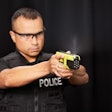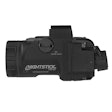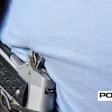Over the years different stances, or shooting platforms, have come and gone with various names attached to them. We could list all of them here but that would take a couple of chapters and some of them are just not worth mentioning. Lately some "shooting gurus" have advocated that no particular stance be used during training because out on the street in a "real gunfight" you're not going to be worrying about your shooting stance; you'll just react. In some respects this may be true, but this statement in its entirety is not correct.
Although you will react in a crisis situation, as stated, you'll react in a certain way every time, not at random. You will automatically go into a shooting stance or platform that is natural, comfortable, and instinctive to you. If that's the case, then to hone your shooting skills most effectively you need to consistently train in this stance. Why train the opposite of how you will really react in a gunfight?
I've found that although I automatically find a natural stance when under stress, it's not always easy to mimic the position when forced to reproduce it during training. To help others find their natural stance while training, I've come up with some helpful guidelines.
Building Blocks
While you may be tempted to try interesting new stances each time you hear about them, it's using the same natural stance consistently that will allow you to lay the groundwork for your shooting skills, just like laying the foundation down on a building.
If you don't have a solid foundation for your house, the building will collapse under pressure. If you don't have a solid platform to shoot from, then your ability to return effective fire at your adversary will collapse under the pressure of an actual fight for your life. Don't complicate matters by fighting against your body's natural inclination.
Your body innately reacts in certain ways under stress. Some people refer to these reactions as auto-kinetic responses. An example would be if someone were to quickly and unexpectedly move his hand in close proximity to your face as if he were going to strike you. Your auto-kinetic response would be to close your eyes and turn your head to the side to protect your eyes. In other words, you would flinch. This is an automatic response that cannot be overcome, even with training.
Understand that no amount of training will overcome your instinct to survive and protect yourself. Your auto-kinetic or instinctive responses are going to take control of you under certain circumstances. Even a boxer, someone who trains by sparring and getting struck in the face, is going to have the same reaction as you would if someone were to quickly and unexpectedly move his hand next to his face as if to strike him. This automatic and instinctive response cannot be avoided. Obviously a trained fighter's counter response (attack) is going to be quicker than yours, but his initial response (flinch) will be the same.
With that being said there are certain automatic responses your body will experience under the sudden rapid traumatic stress of a shooting. This is called your startle response or your fight-or-flight response. Whether your brain has decided to fight or to take flight, the instinctive response from your body, in regards to how you position yourself, is going to be the same. This is what you can reproduce on the range for target practice.
From the Ground Up
The first thing you need to realize is that in a natural shooting stance your feet will be shoulder width apart, just like when you run or walk. If your feet are too wide apart, you'll look like a duck waddling down the road-a very slow duck. If you move from a stance that's too wide into a shoulder width stance while shooting, your gun will come off target as you move. Neither of these is a good move in the middle of a gunfight.
The easiest way to find shoulder width is to stand with your feet together as if standing at attention, with your toes and heels touching. Shift your weight on your heels and spread your toes out as far as they will go while still keeping your heels together. Now spread your heels out so they're even with your toes. This is shoulder width for you.
The next section of your body you need to look at are your knees. They need to be slightly bent. This is so you can take flight and run if you have to or to brace yourself and fight if need be.
Lock your knees and try taking a few steps around the room. You probably feel like you're marching in some Third World country's army. Try to imagine moving quickly while getting shot at with your knees locked-not so easy to do. Now stand with your feet shoulder width apart and bend your knees slightly so they're relaxed and comfortable. Do you feel like you're more ready to take action, whether it's to take fight or flight, from this more natural stance? That's because it's the stance you use walking every day.[PAGEBREAK]Halfway Up
We've laid the foundation with your feet and knees, so let's talk about your waist. It's natural to bend slightly forward at the waist. Again, this is preparation for either taking flight or fighting. If you were to stand straight up with your back stiff you could be easily knocked over, and you certainly don't run with your back stiff and straight. So instead, get into this crouched stance. It's also known as a "combat crouch."
In a crisis, you'll also automatically protect your windpipe by lowering your chin. You can't fight if you can't breathe. Years of evolution have taught us to protect our windpipes so that we can have the air we need to fight-or, in some cases, to flee. Your brain will automatically lower your chin when it recognizes your body is being threatened. Again, this is an automatic response that will occur once your brain has realized that your body is under attack. If it's going to happen in real life under the stress of a fight for your life then why not train this way to be prepared?
Meet the Threat Head On
The last area to discuss, and probably the most important when talking about stances, is the fact that under stress you're going to face your adversary straight on, square to the threat.
Turn on the nature channel and watch any predatory animal hunt its prey or get into a dispute with another predator. They don't stiffen their backs and legs or turn sideways to their adversary. They crouch down and face the danger straight on. We do the same things.
Both of our eyes are open because we are visual creatures.
Unfortunately, when our startle response kicks in on us another instinctive automatic response that occurs is tunnel vision. This reduces your vision by roughly 70 percent, which means you'll be operating with about 30 percent of your normal field of view.
This again goes back to years of evolution. When people were hunters and gatherers lo those many years ago, as hunters we focused in on our prey because a missed shot meant we went hungry. Plus, sometimes our prey tried to turn around and make us the meal. Because of this we have evolved to focus on the task at hand.
Think back to when you had to tighten a nut that was in a tight spot on your car's engine. Or had to replace a washer and nut on a sink that was in an awkward spot. You don't look around the engine compartment as you're trying to get that nut to fit on the bolt. The last thing you want to do is cross thread that nut and washer onto your kitchen faucet. We focus on the task at hand to get the job done properly. Now take that level of focus and combine it with your startle response mechanism and it's easy to see why we focus on the source of the danger with both our eyes open.
In a real life gunfight are you really going to be consciously worrying about your stance? No, of course not. It will come to you naturally. But knowing this, it only makes sense to train in the same way you'll react under stress during that gunfight. It makes more sense to train the way you're going to react and that is naturally and instinctively. With your feet shoulder width apart, your knees bent and bent slightly forward at the waist with your chin lowered and both of your eyes open.
If you doubt the validity of this stance I can tell you that several police academies have switched over to teaching this stance to their new recruits with dramatic results. Before switching over to this stance it would take approximately 700 to 900 rounds per recruit to get them to a point where they could hit the target consistently. After switching over to teaching this stance to the new recruits it now only takes about 400 rounds to get them up to speed. I firmly believe this results from building a solid foundation on which to build their shooting skills.
Michael T. Rayburn is 27-year veteran of law enforcement and is currently an adjunct instructor at the Smith & Wesson Academy. He is the author of three books, "Advanced Vehicle Stop Tactics," "Advanced Patrol Tactics," and "Basic Gun Fighting 101."

















